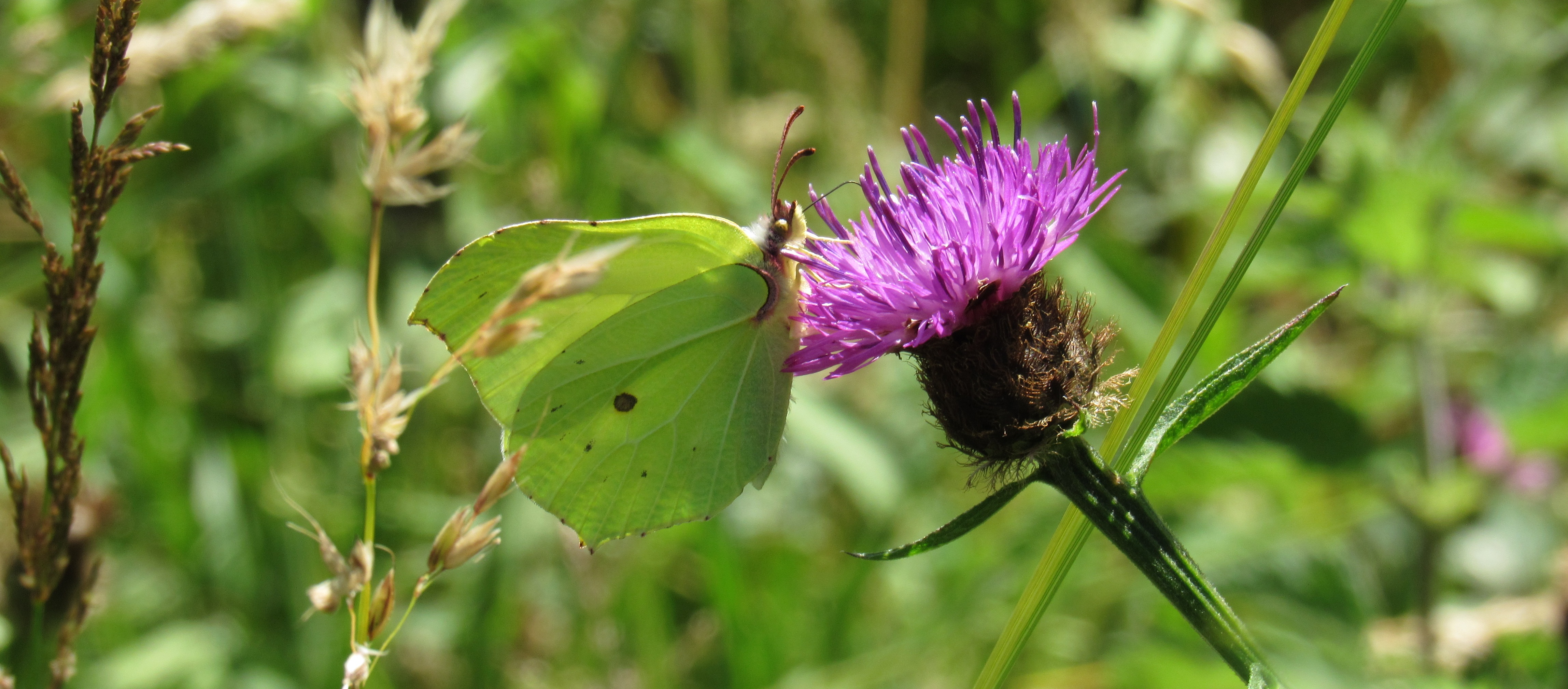
LATEST SIGHTINGS
This picture of a Brown Hairstreak was spotted in a North Curry garden on the 26 July (photo: Paul Deacon).
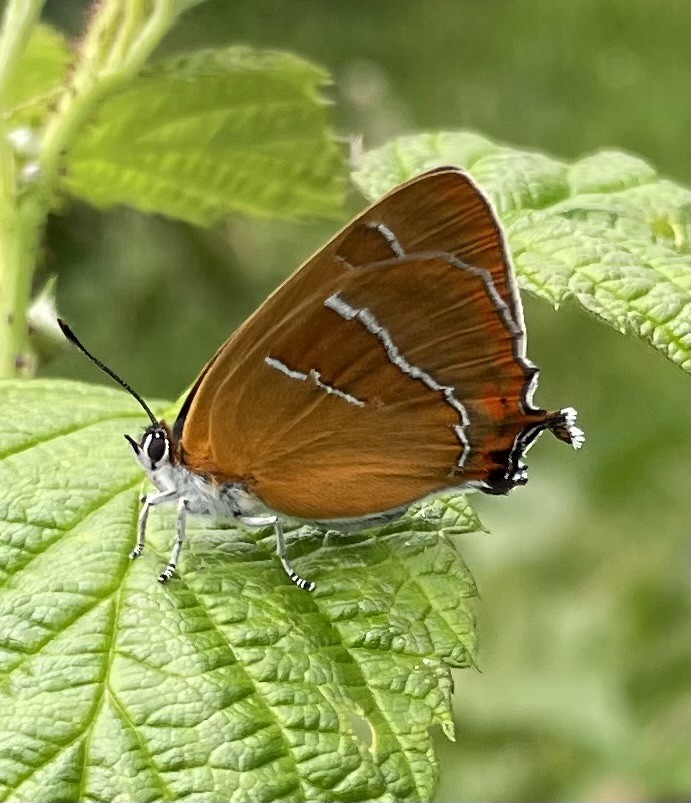
BUTTERFLIES OF THE COMMUNITY WOODLAND
By Sue Ashton (text and photos)
Twenty-three species of butterfly have been seen at the Community Woodland and sports field over the past few years, although numbers fluctuate and not all species are seen in each year. The ‘butterfly bank’ (please see Projects section) was created at the woodland in 2017 to provide habitat for Common Blue, Brown Argus and Small Copper, in particular.

The list of butterflies seen at the woodland site is as follows: Small Skipper, Essex Skipper, Large Skipper, Brimstone, Large White, Small White, Green-veined White, Orange Tip, Small Copper, Brown Argus, Common Blue, Holly Blue, Brown Hairstreak, Red Admiral, Painted Lady, Small Tortoiseshell, Peacock, Comma, Speckled Wood, Marbled White, Gatekeeper, Meadow Brown, Ringlet.
Below is a very brief guide to the butterflies you may see at the woodland and when to see them. For more information about different species of butterfly, please see Butterfly Conservation’s site: https://butterfly-conservation.org/50/identify-a-butterfly.html Or see UK Butterflies: http://www.ukbutterflies.co.uk/index.php
For a blog on how the 'butterfly bank' fared in its first year, please click on this link: http://northcurrywildlife.blogspot.com/2019/03/the-butterfly-bank-first-year-account.html
THE OVERWINTERERS
The first butterflies to be seen on warm sunny days at the start of the year are ones that have overwintered as adult butterflies (and not as eggs, larvae/caterpillars or in the pupal/chrysalis state). These are ones we are generally familiar with as garden visitors, such as the Red Admiral, Peacock, Small Tortoiseshell and Comma, but also the Brimstone whose bright primrose yellow colour (in the male, the female is a more greenish white) is a lovely herald of spring. All these species can be seen in and around the Community Woodland and sports field. They mate in spring and their offspring become the newly emerged adult butterflies that we see in summer (before they overwinter themselves).
Red Admiral
A large and striking dark butterfly with flashes of red on its upper and lower wings. Native butterflies that overwinter here are joined by migrants from the continent as the weather warms.
They lay their eggs on nettles and can be quite numerous at the end of the summer. They can often be found in autumn feeding on overripe blackberries in the hedges around the White Street football field.
Peacock
This butterfly is easily recognised by the eyespots in the corners of its wings which are reminiscent of the ‘eyes’ of a peacock bird’s tail. This is another garden visitor, which overwinters in our sheds and outhouses, and lays its eggs in spring on nettles. It can be quite plentiful in the summer.
Look out for it nectaring on knapweed at the Community Woodland or on buddleia in your garden.
Small Tortoiseshell
Slightly smaller than the Peacock, this is a familiar butterfly in our gardens (and frequently comes into our sheds and houses to overwinter), and used to be a common butterfly but is faring less well at the moment.
Its wings are richly patterned with chequered black and gold along the leading edge of its forewings and brilliant blue studs along the bottom of its lower wings. It also lays its eggs on nettles and can be seen at the Community Woodland nectaring on knapweed in the summer months.
Comma
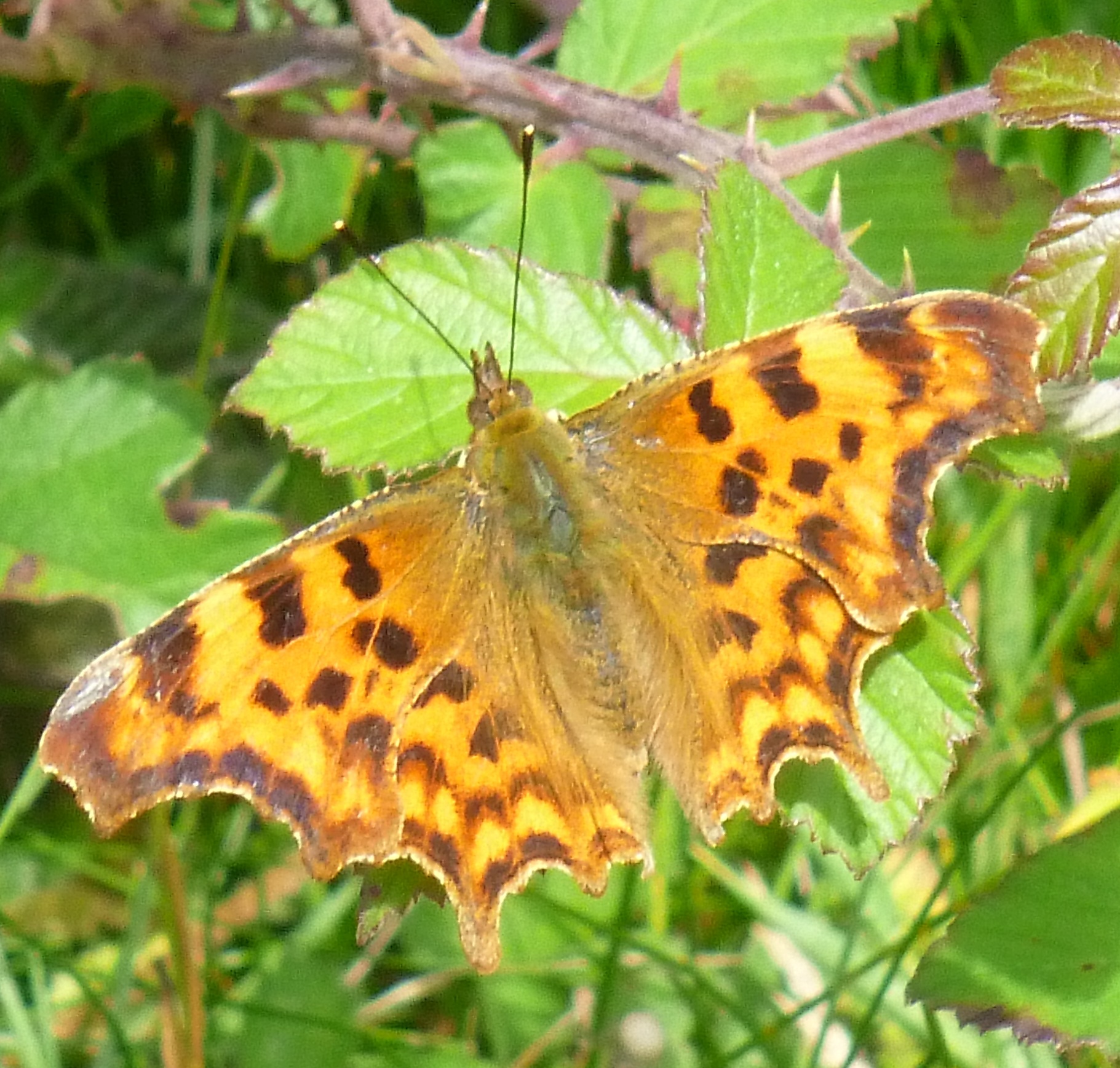
Perhaps a less familiar butterfly, although it does come into gardens. It is easily recognised by its rich golden colour and by the edges of its wings which appear ragged or scalloped. When its wings are closed, it is well camouflaged and looks just like a dead leaf.
Its name comes from the fact that it has a small white mark on its underside that resembles the curved ‘comma’ punctuation mark. Like the Red Admiral, Commas are most likely to be found in the hedgerows around the football field feasting on overripe blackberries in the autumn sun. They overwinter among vegetation.
Brimstone
A beautiful spring butterfly. The male is a deep primrose yellow and the female is lighter – more a greenish white. Both have leaf-shaped wings and antennae like pink stalks, so they are well camouflaged when sheltering in foliage.
They overwinter as adult butterflies and are out with the first sun of spring, laying their eggs on buckthorn or alder buckthorn, so you may see a female laying at the Community Woodland. In the summer, the next brood (the offspring of the spring butterflies) may be seen at the woodland nectaring on knapweed or burdock.
SPRING EMERGEES
After the 'overwinterers', the next butterflies to appear in spring are those that have passed the winter in the pupal state and now emerge from their chrysalises as adult butterflies. Those first to emerge once it is warm enough are generally Orange Tips, Holly Blues, Speckled Woods and Small and Green-veined Whites.
Orange Tip
Only the males have orange tips to their wings, but they are the ones you are most likely to see. They have been seen at the Community Woodland or can be seen flying along local hedgerows or where their caterpillar food plants (lady’s smock and garlic mustard) are found.
The females are a similar shape, but have grey tips to their wings instead of orange. Both sexes have mottled green underwings which camouflage them perfectly when resting on foliage such as cow parsley. But in flight the males are very noticeable and can be seen patrolling the hedgerows looking for females.
Holly Blue
These are very small blue butterflies which can often be seen in shrubs and hedgerows or flying between them (you may see them in your garden). In North Curry churchyard, they can be seen at the tops of the yews or flying between the yews and the big holly tree next to the path on the eastern side.
At the Community Woodland, they are most often found in the hedge on the eastern border (the sunniest side).
The upper wings of males are a beautiful plain blue, while the females have a broad band of black on the edge, but both have very pale blue undersides, dotted with small black specks, so they can look very light – almost grey or white – in flight, and are easily missed against a blue sky.
They are most often seen in flight, but can occasionally be seen nectaring on flowers, looking particularly lovely on forget-me-nots.
Speckled Wood
A brown butterfly with a delightful yellow/orange spotted pattern. They are well camouflaged for the areas of dappled shade they seem to favour.
They can be found in woodland and along hedgerows where males patrol looking for females or else they perch in a favourite spot and then fly up to investigate anything that flies past – whether another butterfly, bee or fly. You may see two males sparring: a characteristic pattern is for the two to fly upwards, circling around each other, even batting wings, until one breaks away and flies off.
Small White
Small White butterflies have black tips to their upper wings; the males have a single spot on their upper wing, the females have two spots. These markings are very pale in the spring emergees, but darker in the summer brood. The underside of their hind wings can be a lovely pale cream, especially if they are freshly emerged.
They have a delightful flight pattern and can often be found in gardens fluttering over flowers, particularly lavender. At the Community Woodland, they are most often seen flying through or occasionally nectaring on knapweed. They lay their eggs on many plants, including members of the cabbage family, but will also lay on nasturtiums. If you plant some nasturtium in your garden you will have the pleasure of seeing the caterpillars growing and perhaps even pupating and emerging as butterflies in the summer.
Green-veined White
Green-veined Whites are very like Small Whites, but have pronounced veins in their wings, particularly on the underside, which appear green or greyish, though it is hard to see this in flight and a Green-veined White is best identified at rest.
They are generally a bit earlier to emerge than Small Whites and seem to be a bit hardier, being out and about when it is slightly less warm and preferring more damp or woodland areas, though they are frequently found in gardens too.
Large White
A similar butterfly to the Small White and generally larger, but it is hard to differentiate them in flight, and size in not an infallible guide.
At rest, it will be noticed that the males have no spots on their upperside (unlike the single spot of the Small White), and while the females have two spots like the female Small White, the black tips to the wings in both sexes are more noticeable and tend to go around both the upper and lower edges of the wing (whereas the Small White is just tipped in black).
Again like the Small White, Large Whites tend to have paler markings in the spring brood than the later summer one. They can be seen at the Community Woodland flying through or nectaring on knapweed.
SUMMER GRASSLAND BUTTERFLIES
The Community Woodland really comes into its own for butterflies in the summer months. From mid-June onwards, Large Skippers, Meadow Browns, Ringlets and Marbled Whites appear, and numbers build into July, being joined by generally good numbers of Small Skippers and, later, Gatekeepers. These are all butterflies that lay their eggs on species of grass and so are found where there is good grassland or in grassy hedgerows, though they can make their way into nearby gardens for nectar. We are very lucky to have such a profusion of these butterflies on our doorstep at the woodland thanks to the varied grass habitat and rich flower sources for nectar.
Large Skipper
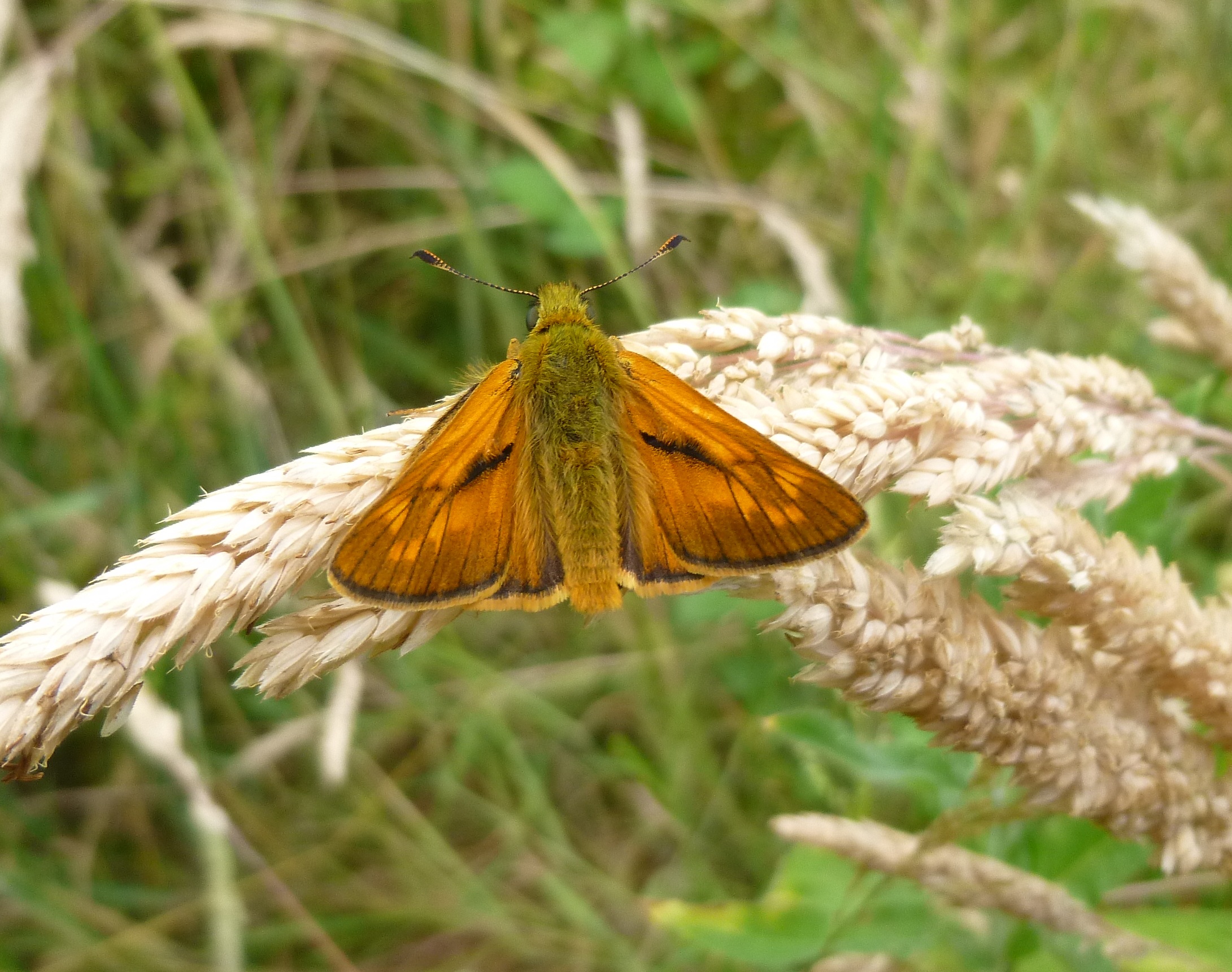
The ‘large’ is only in relation to the Small Skipper: this butterfly is really quite tiny and can be found on the purple flower heads of knapweed or yellow bird’s-foot trefoil. It is a bright, golden orange with rather triangular wings and it can hold its upper wings at an angle to the lower wings so that it doesn’t look like a ‘traditional’ butterfly. They are very attractive insects and are fast flyers, particularly in hot weather. Watch the males (who have a black line on their upper wings) zipping around, chasing off other males or pursuing females. In cooler weather, you may see them resting on knapweed or on grasses.
Meadow Brown
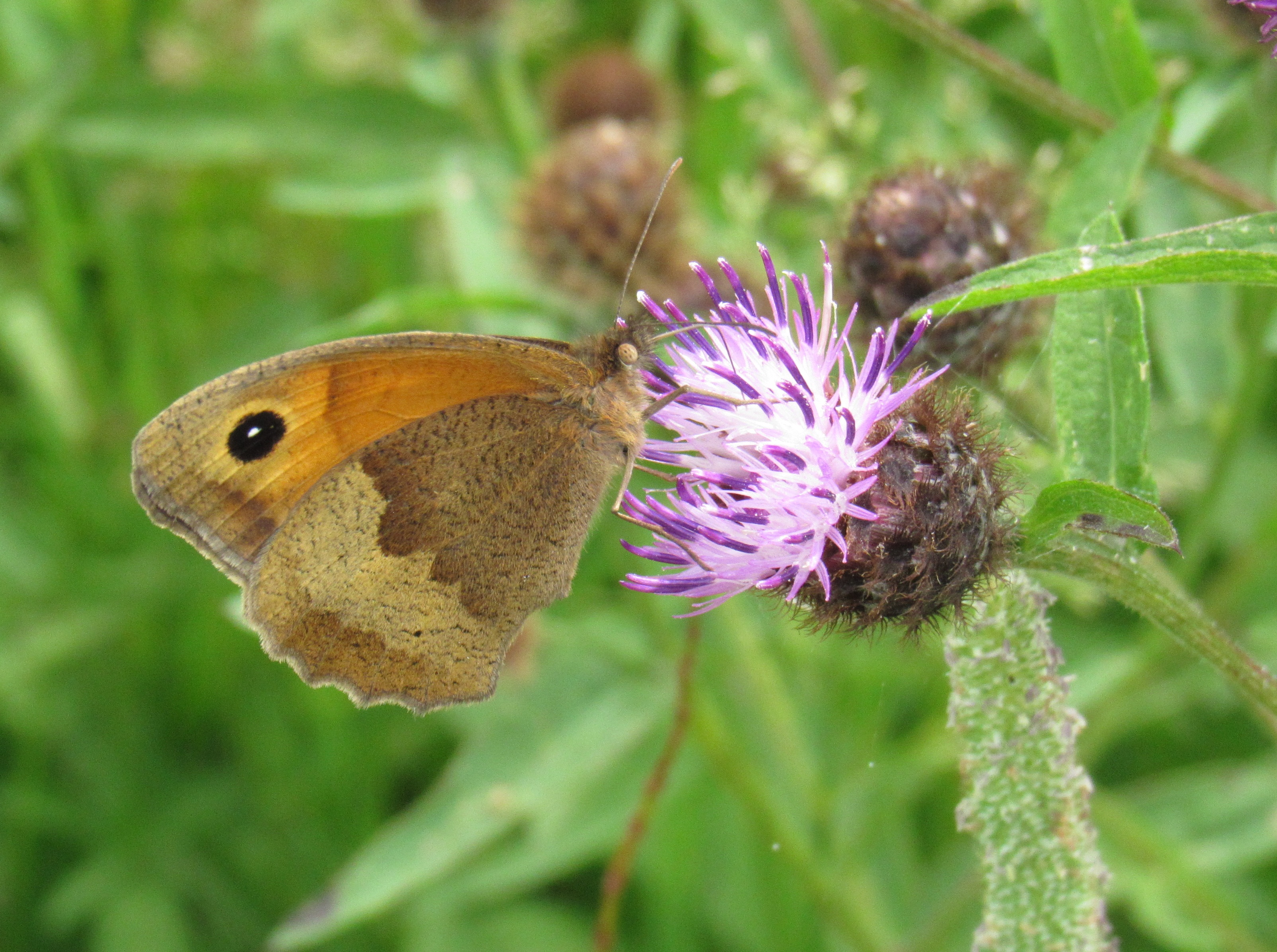
A lovely sign of summer, the Meadow Brown is an orangey brown butterfly which inhabits grassy areas and occasionally comes into gardens for nectar. The males’ upper wings are darker than the females (the females have patches of orange) but both have eye spots in the top corners of their forewings. Their forewings are also orange underneath so they have quite an orangey brown appearance in flight. You will see them nectaring on the purple knapweed at the woodland or flying over and between the tall grasses. They have a rather upright flight as they appear to ‘swim’ amongst the grasses.
Ringlet
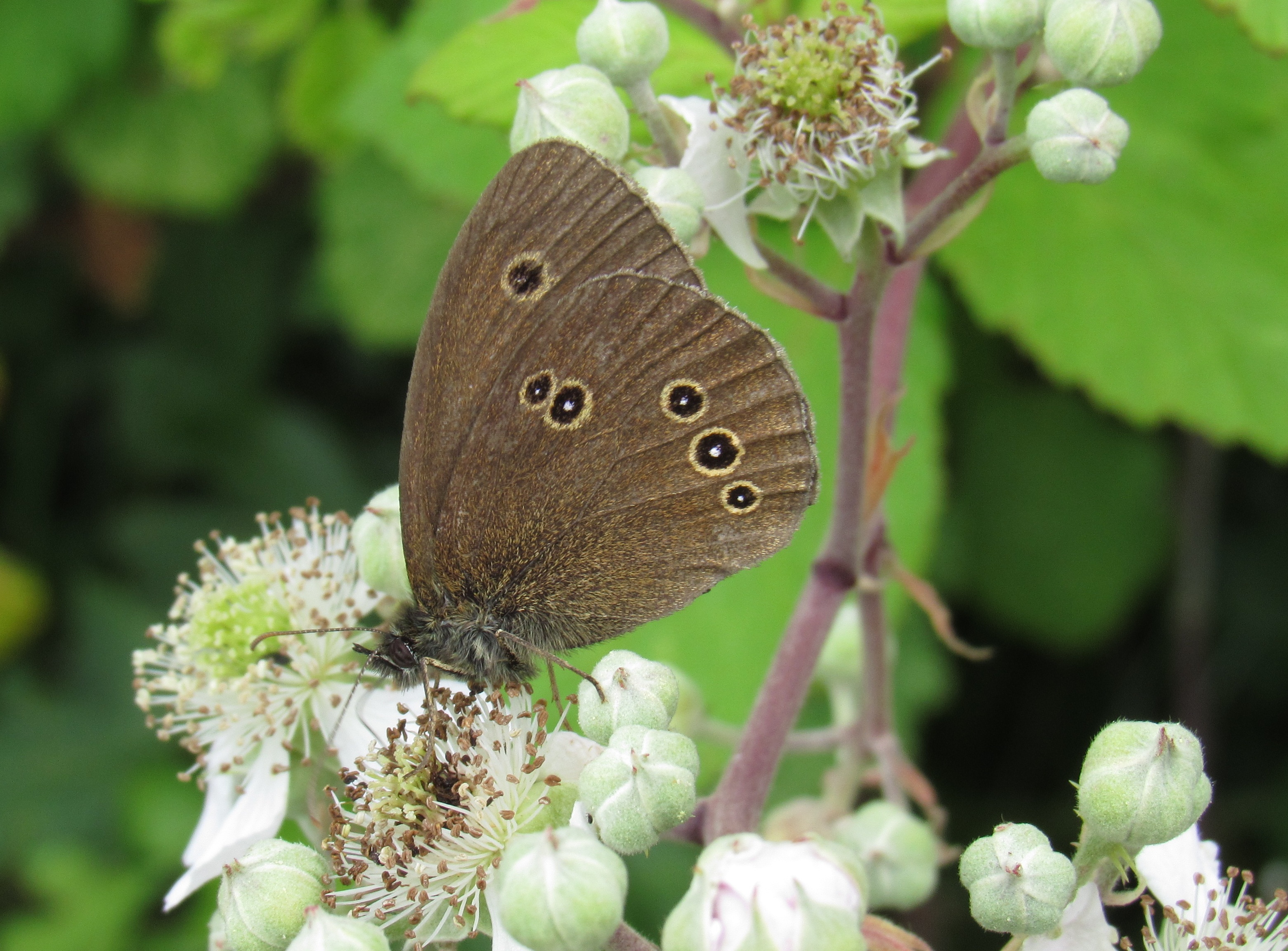
Very beautiful dark chocolate brown butterflies, Ringlets can often be found flying on cloudy days or on the shadier side of the woodland site, nectaring on bramble blossom. They are darker than Meadow Browns and when newly emerged have a white border around the very edge of their wings. They tend to fade in colour and lose this border as they age. Their name comes from the series of little rings they have on their underwings, though these can only be seen when the butterfly is at rest with wings closed. Like the Meadow Brown, they have a lovely, rather upright, jinking flight as they fly amidst the tall grasses.
Marbled White
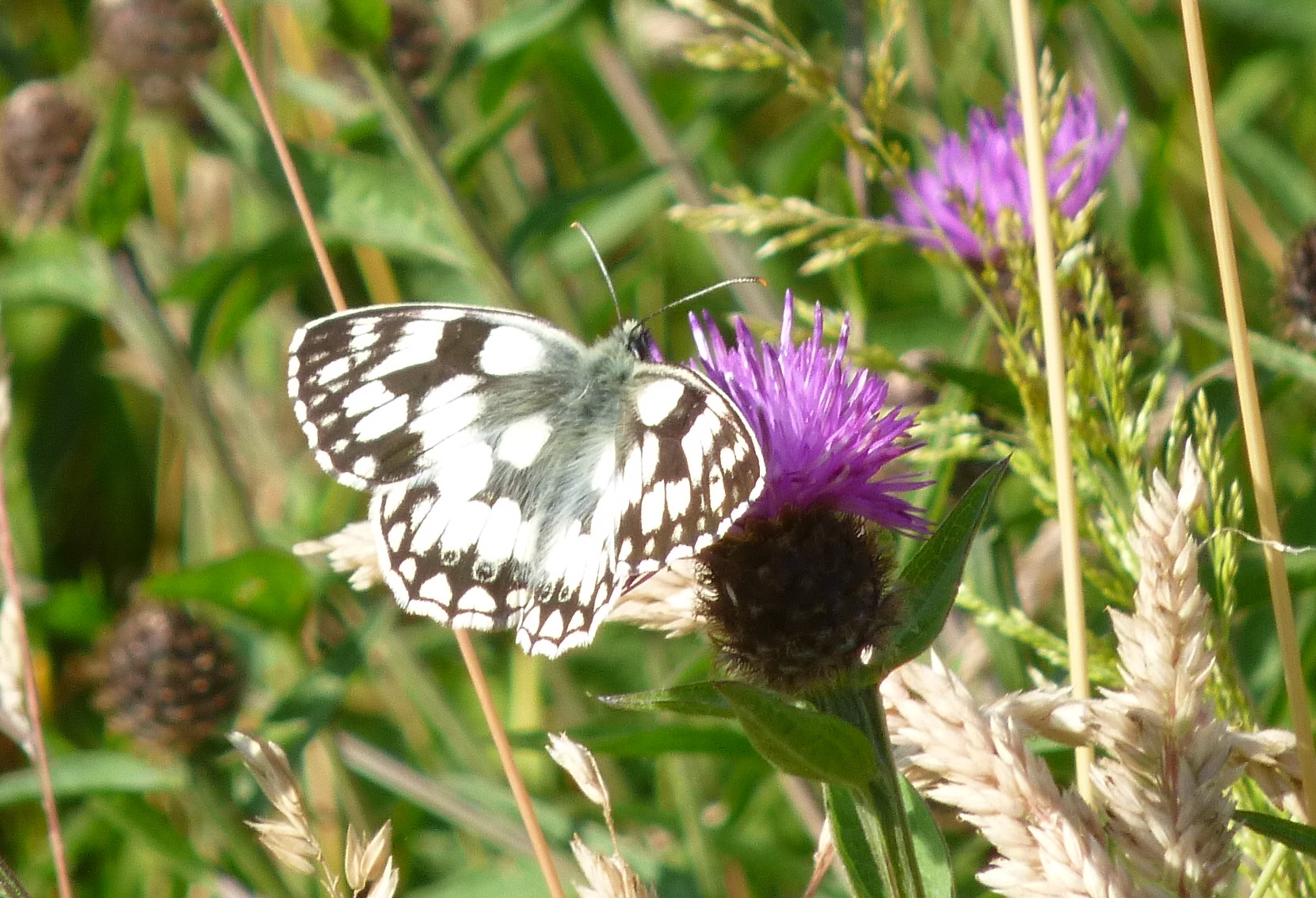
Related to both Meadow Browns and Ringlets, the Marbled White is a chequered black and white butterfly with a gorgeous pattern on its under wings. If you manage to find one resting with its wings closed, have a look (you may need binoculars!) at the lovely mosaic of squares and spots in black, grey and white on its underside.
Though not as nu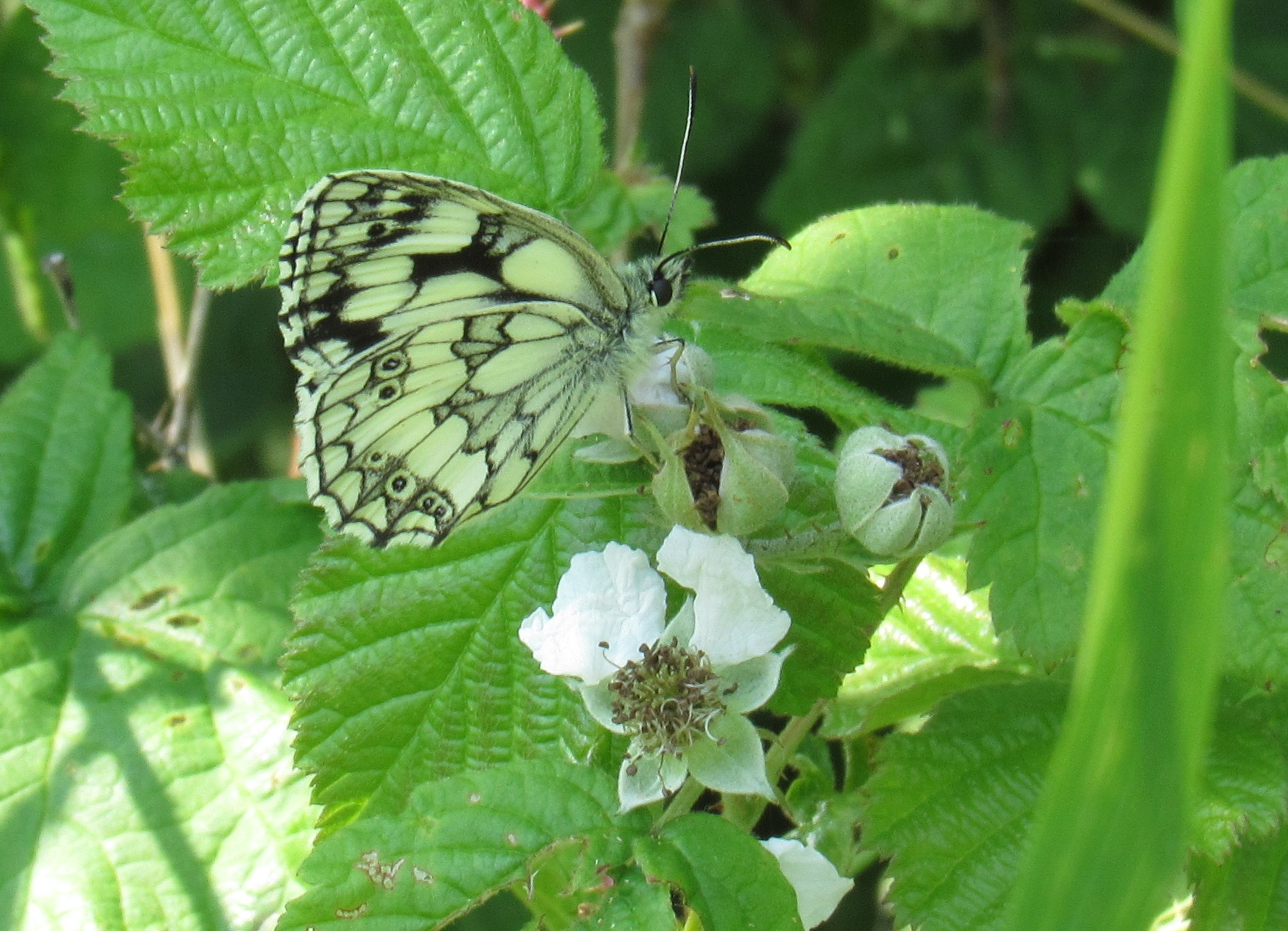 merous as the Meadow Browns and Ringlets, it can be found at the woodland, nectaring on the purple knapweed or flying over the grass. It is by no means a common butterfly and so we are very fortunate to have them in the summer at the woodland.
merous as the Meadow Browns and Ringlets, it can be found at the woodland, nectaring on the purple knapweed or flying over the grass. It is by no means a common butterfly and so we are very fortunate to have them in the summer at the woodland.
Small Skipper
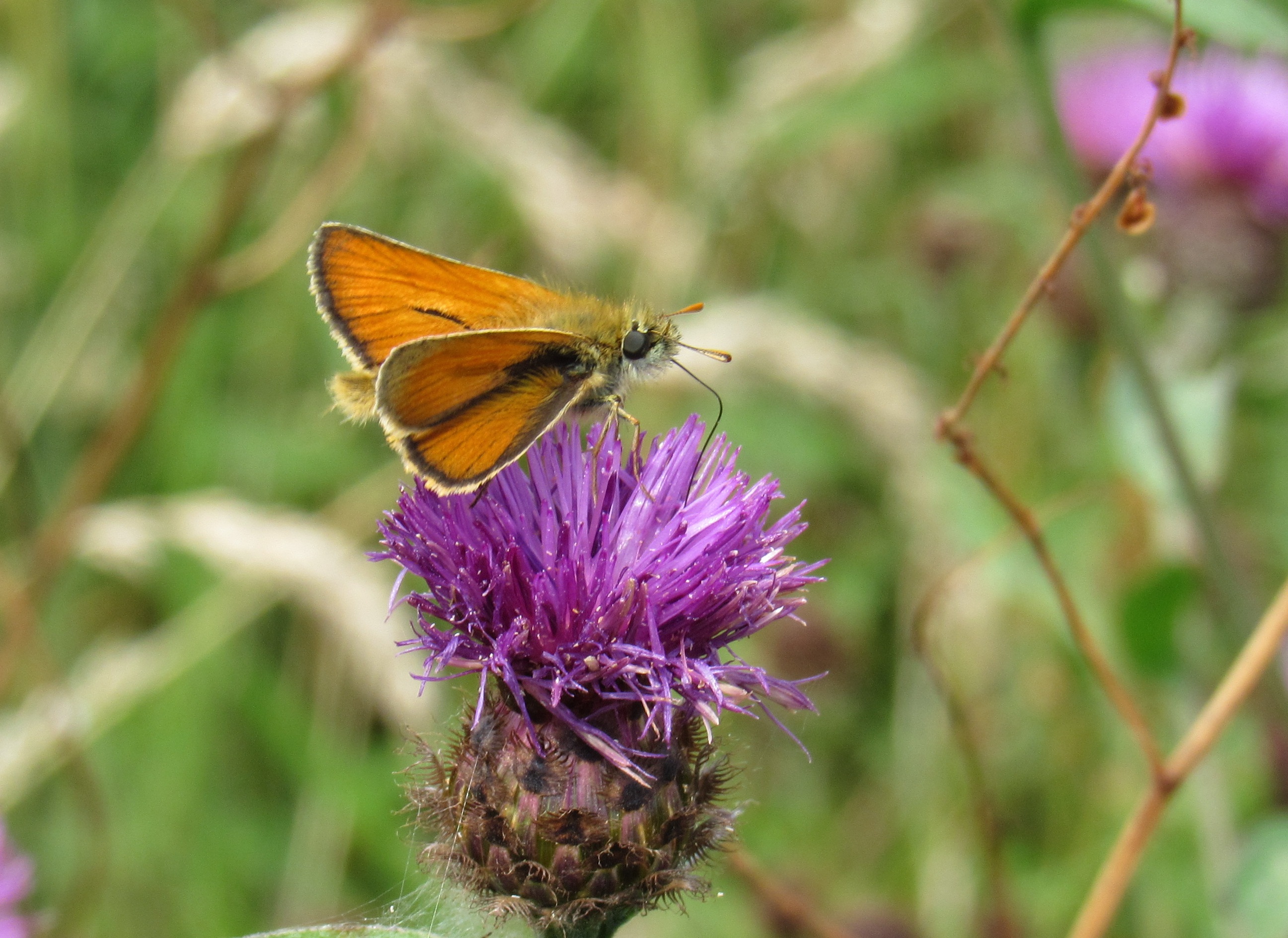
Emerging slightly later than the Large Skipper, the Small Skipper is a very similar butterfly in shape (and hardly any smaller) but with a more uniform and less mottled golden orange wing colour (the males also have a black line on their wings).
These are very appealing butterflies which dart about the woodland on sunny days and only come to rest when it is cloudy when you can see them more easily roosting on stalks of grass or knapweed.
Like the Large Skipper, they lay their eggs within a grass sheath where the newly hatched caterpillars overwinter, feeding up in spring on fresh leaves before pupating at the base of the grass and then emerging in the summer.
Essex Skipper
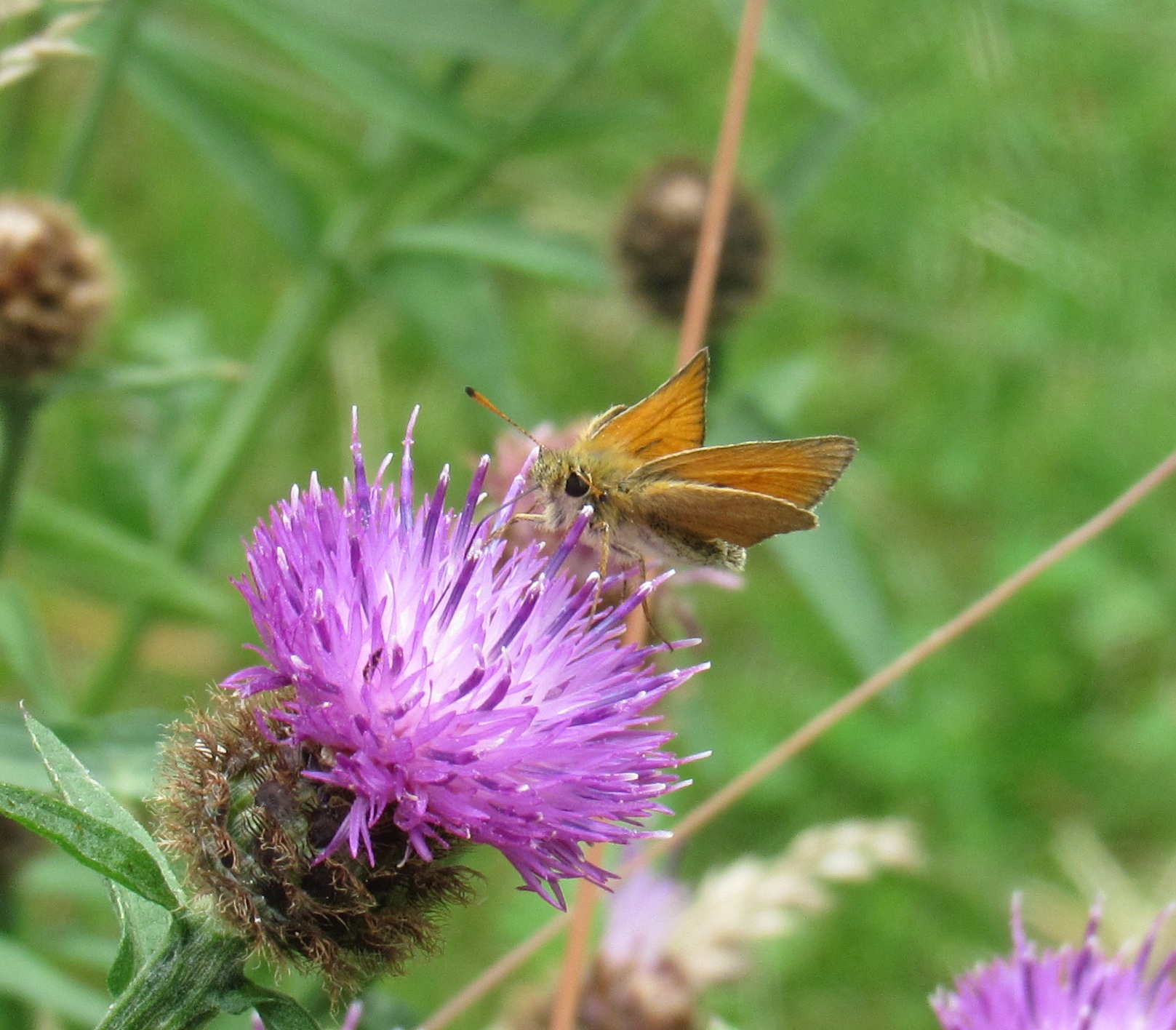
This looks an almost identical butterfly to the Small Skipper, but the most obvious difference are the black tips to its antennae. It wasn’t discovered as a separate species until the late nineteenth century and is easily mistaken for the Small Skipper. It is widespread in south-east England but is expanding its territory west and north. Its behaviour is similar to the Small Skipper and it is a delightful butterfly to observe.
Gatekeeper
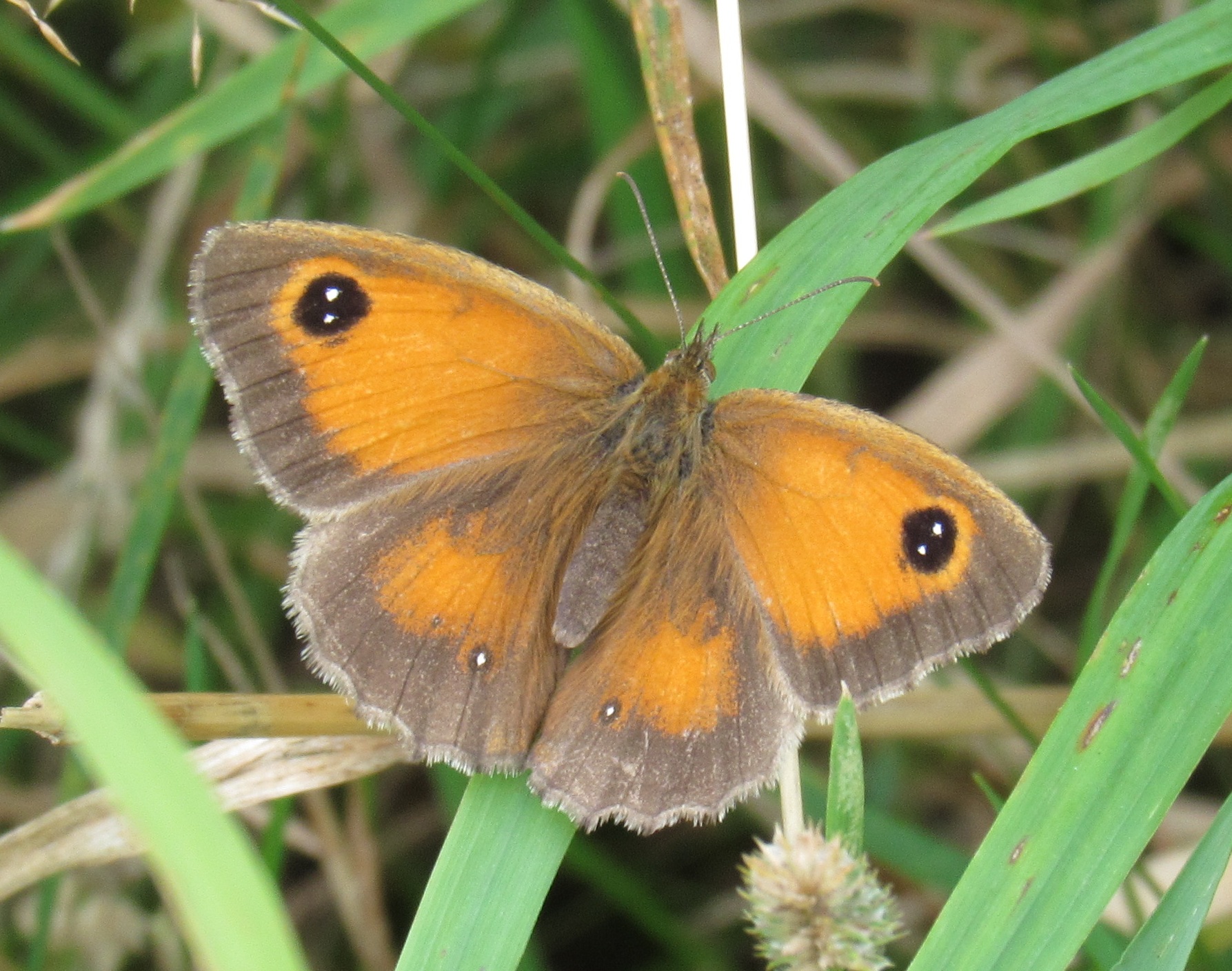
A butterfly similar to the Meadow Brown, but smaller and emerging slightly later, is the Gatekeeper. Its wing colouring is brown and orange, but it has two white dots in the black eye spot on its upper wing while the Meadow Brown had a single spot. The males have broad bands of brown across the orange on their upper forewings (the picture shows a female).
Gatekeepers are mostly seen in hedgerows (they were formerly known as the Hedge Brown), and at the woodland are most frequently found on the thistle and bramble flowers on the western boundary in July and into August.
SMALL BUTTERFLIES OF SPRING AND SUMMER
Common Blue
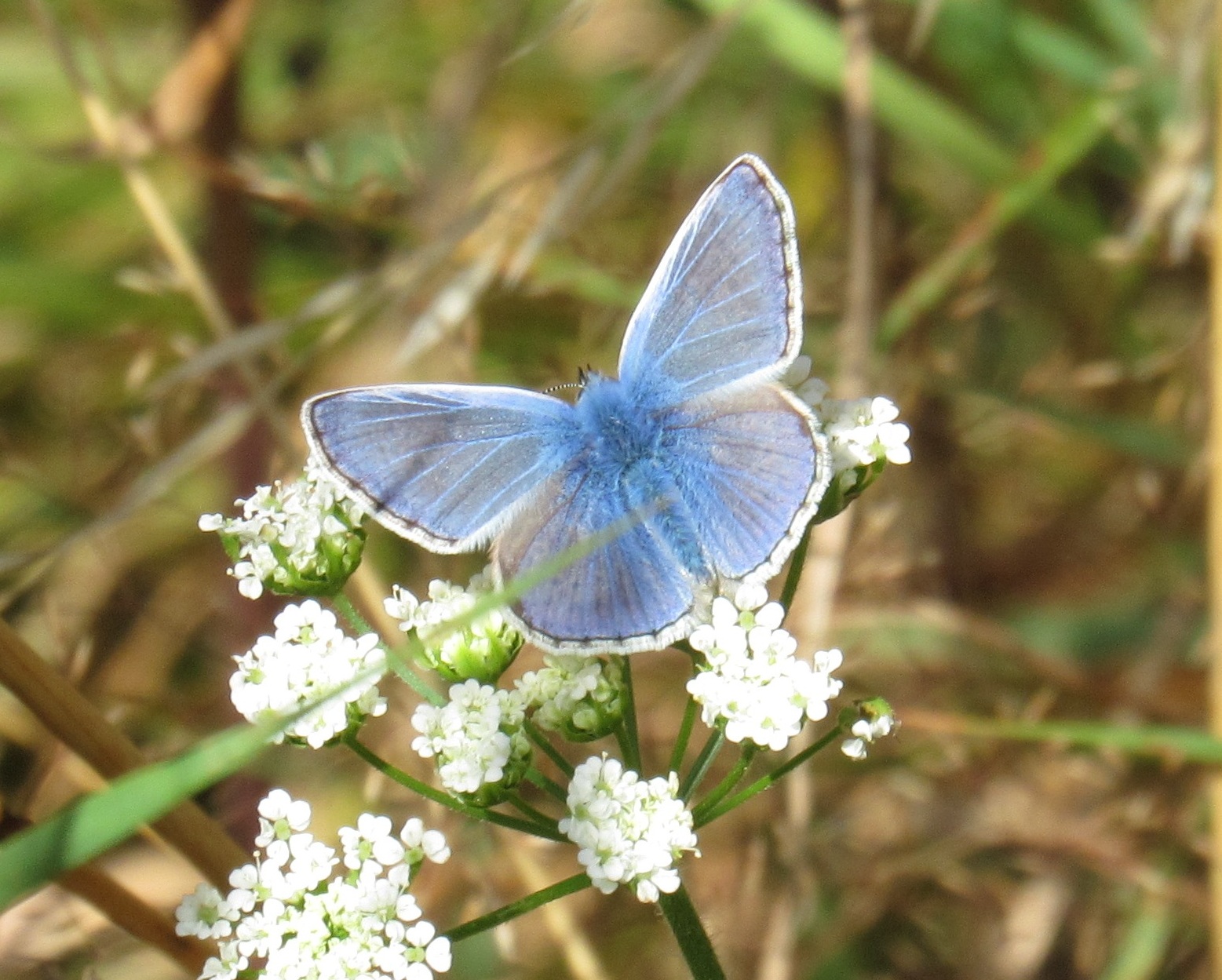
A delightful small butterfly which, despite its name, is not at all common but can be seen at the woodland in good years.
It relies on bird’s-foot trefoil as a caterpillar food plant, so it is hoped that we can boost numbers by helping this plant to flourish on the ‘butterfly bank’.
Male butterflies are a very vivid blue (especially when freshly emerged), while the females are brown with just a tinge of blue (though this can be surprisingly strong in some individuals) and with orange spots along the edges of the upper wings.
These small butterflies love the sun and can be 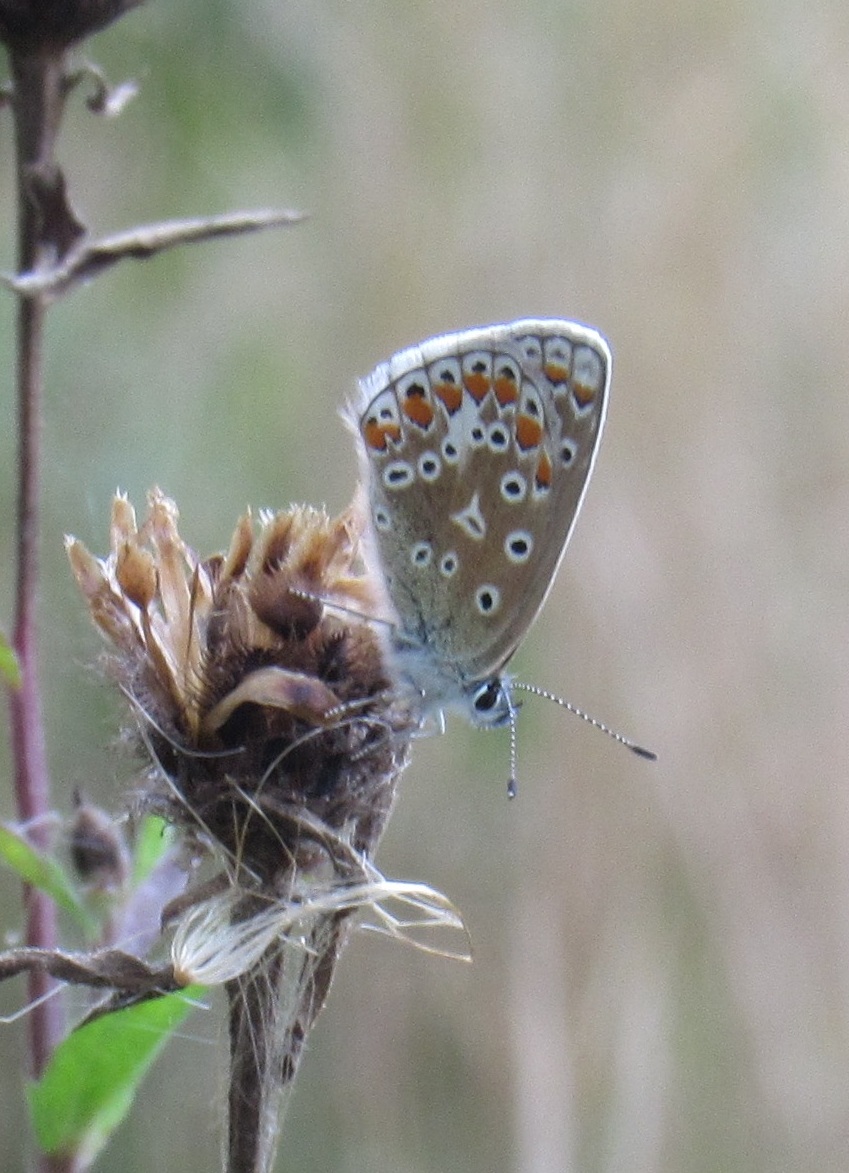 found nectaring on bird’s-foot trefoil or other flowers when the sun is out.
found nectaring on bird’s-foot trefoil or other flowers when the sun is out.
When the sun is in, they roost head down with folded wings on grass stalks or seed heads and are more difficult to see as the underside of their wings is pale brown with black and orange spots.
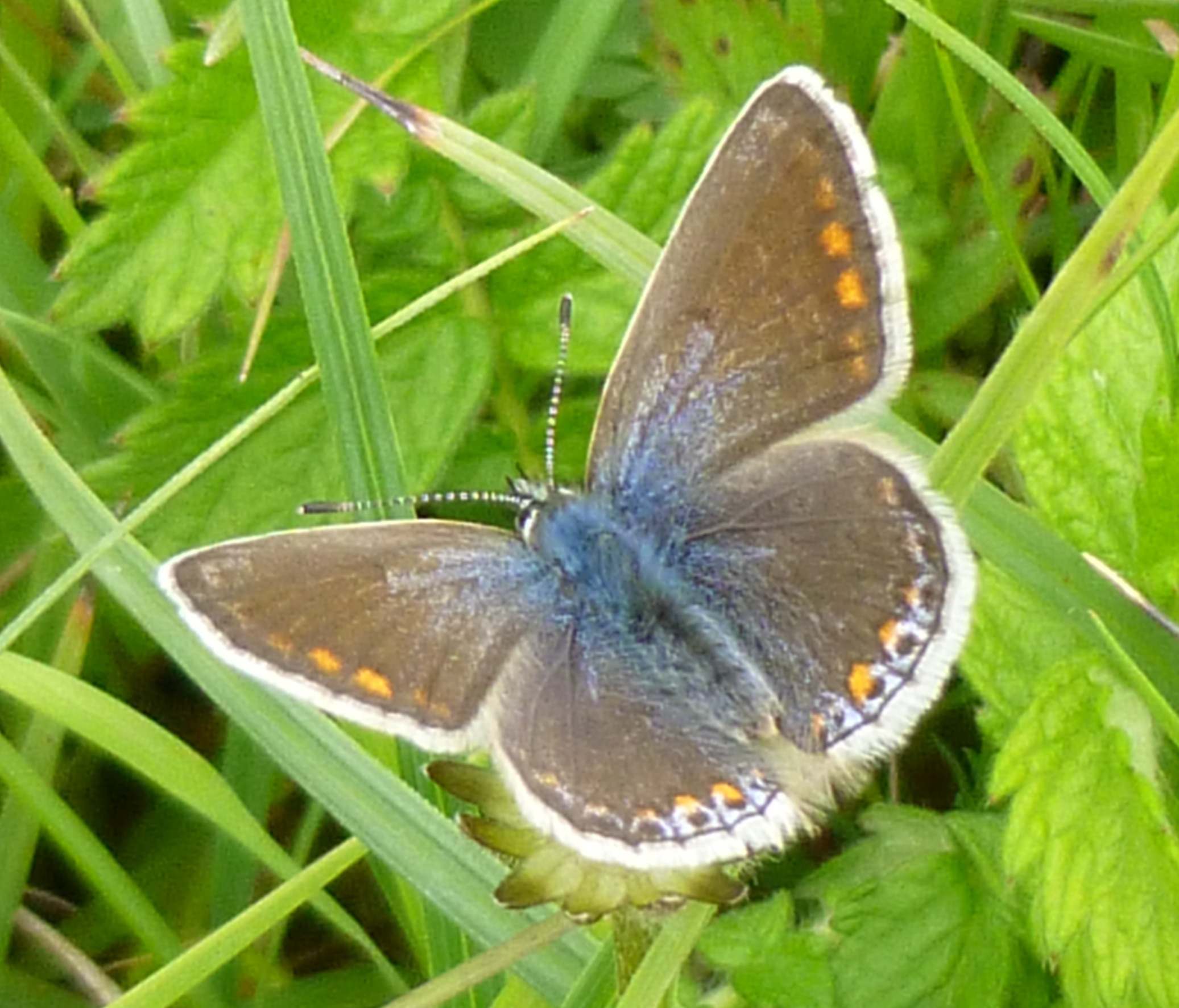
Small Copper![]()
This small butterfly is a brilliant metallic copper colour and really shines in the sun! If you are lucky, you may see it at the woodland site, generally low to the ground, perhaps nectaring on clover. You may see it in its first brood in May or (more likely) in its second brood in July or August; it sometimes has a third brood in September in a good year and can occasionally be quite numerous in the autumn.
It lays on common sorrel and sheep’s sorrel and we are hoping to provide better habitat for it with the butterfly bank.
Brown Argus
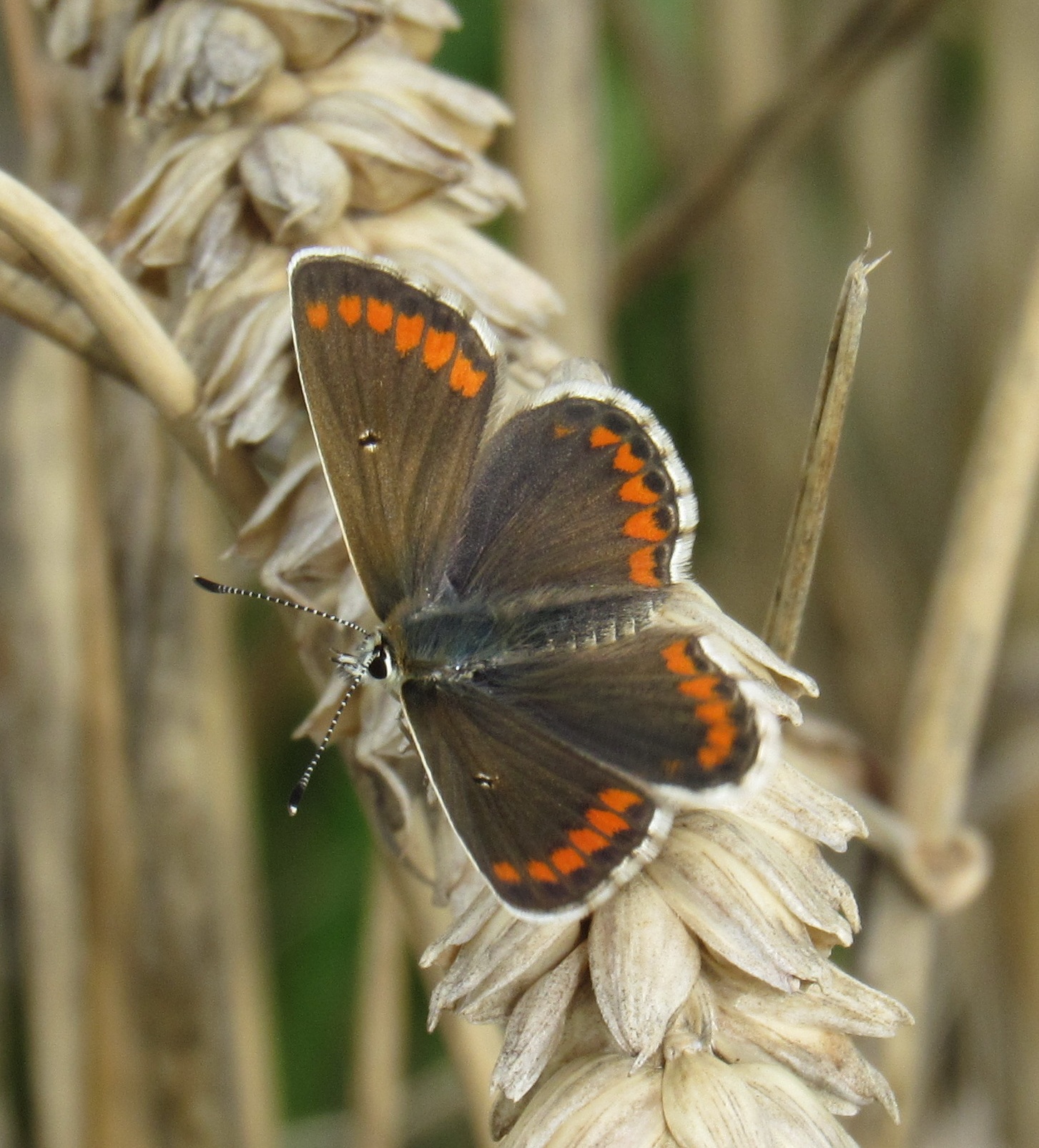
Another very small butterfly, the Brown Argus has been seen at the woodland site, but is a rare visitor. If you see one, do let us know.
They are a lovely chocolate brown with orange dots around the outer edges of their wings, the females having slightly more evidence of orange right to the tips of their forewings. The underside of both sexes is a grey/brown with black and orange spots (rather like the Common Blue) and they can look very pale and silvery in flight.
This is another butterfly that we would like to help by means of the nectar and food plants of the butterfly bank. It lays primarily on common rock-rose, dove’s-foot cranesbill and common storks-bill.
LATE SUMMER BUTTERFLIES
Red Admirals and Comma butterflies can frequently been seen in the hedgerows around the woodland site feasting on rotten blackberries in any late autumn sun. Another late summer butterfly is the rare Brown Hairstreak which lays its eggs on blackthorn.
Brown Hairstreak
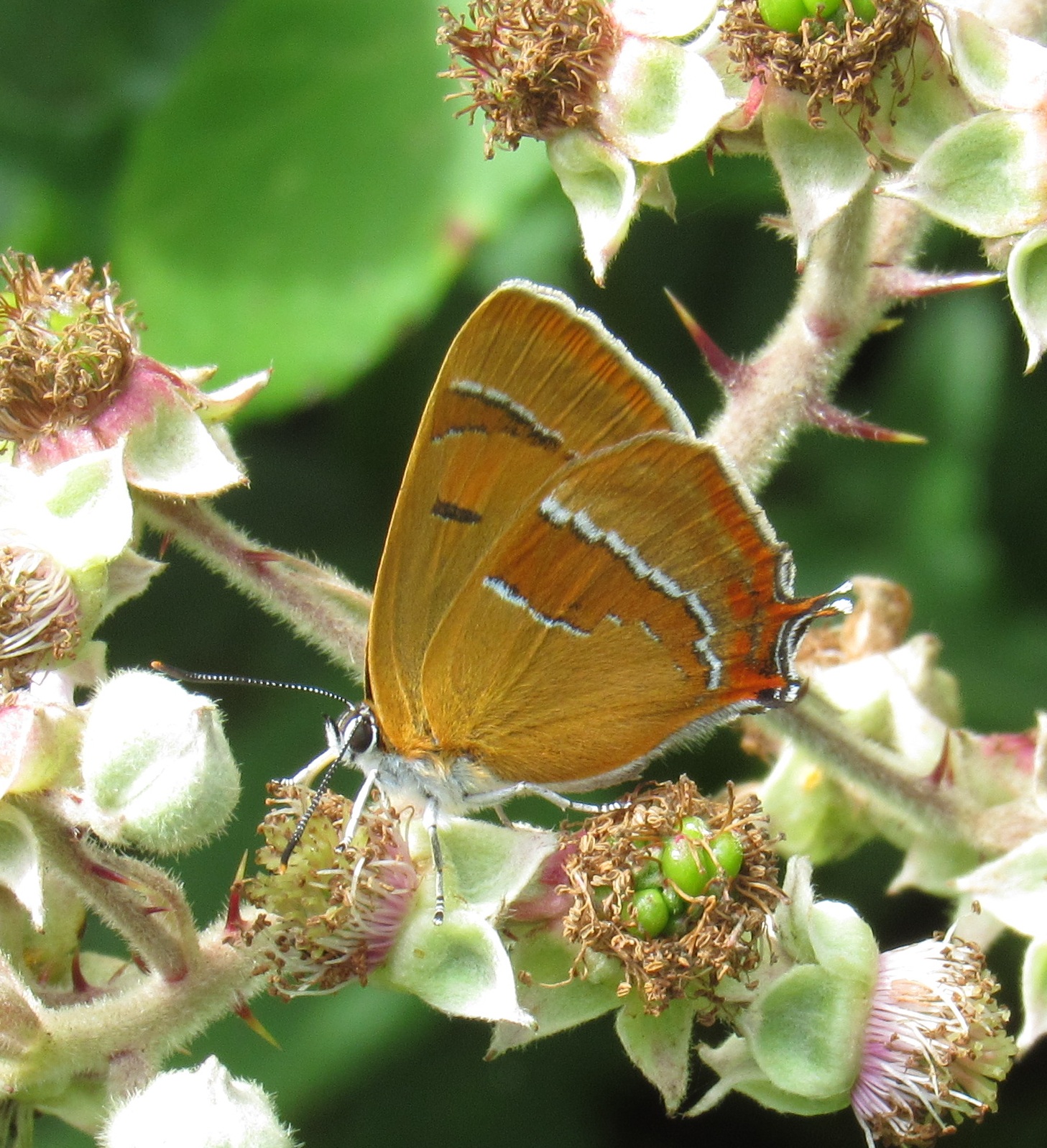
The Brown Hairstreak is a very beautiful late summer butterfly with a gorgeous golden-streaked underside, particularly in the female. It lays its eggs on blackthorn which is very plentiful in this area but mainly in hedgerows. Unfortunately, it lays late in the season and the eggs don’t hatch till spring, so many eggs are lost when hedges are routinely flailed. The Brown Hairstreak therefore only tends to thrive in nature reserves or where some blackthorn hedges are left untrimmed.
An egg-laying female was seen in a hedgerow near North Curry meadow in 2017 and eggs found, but the hedge was later cut.
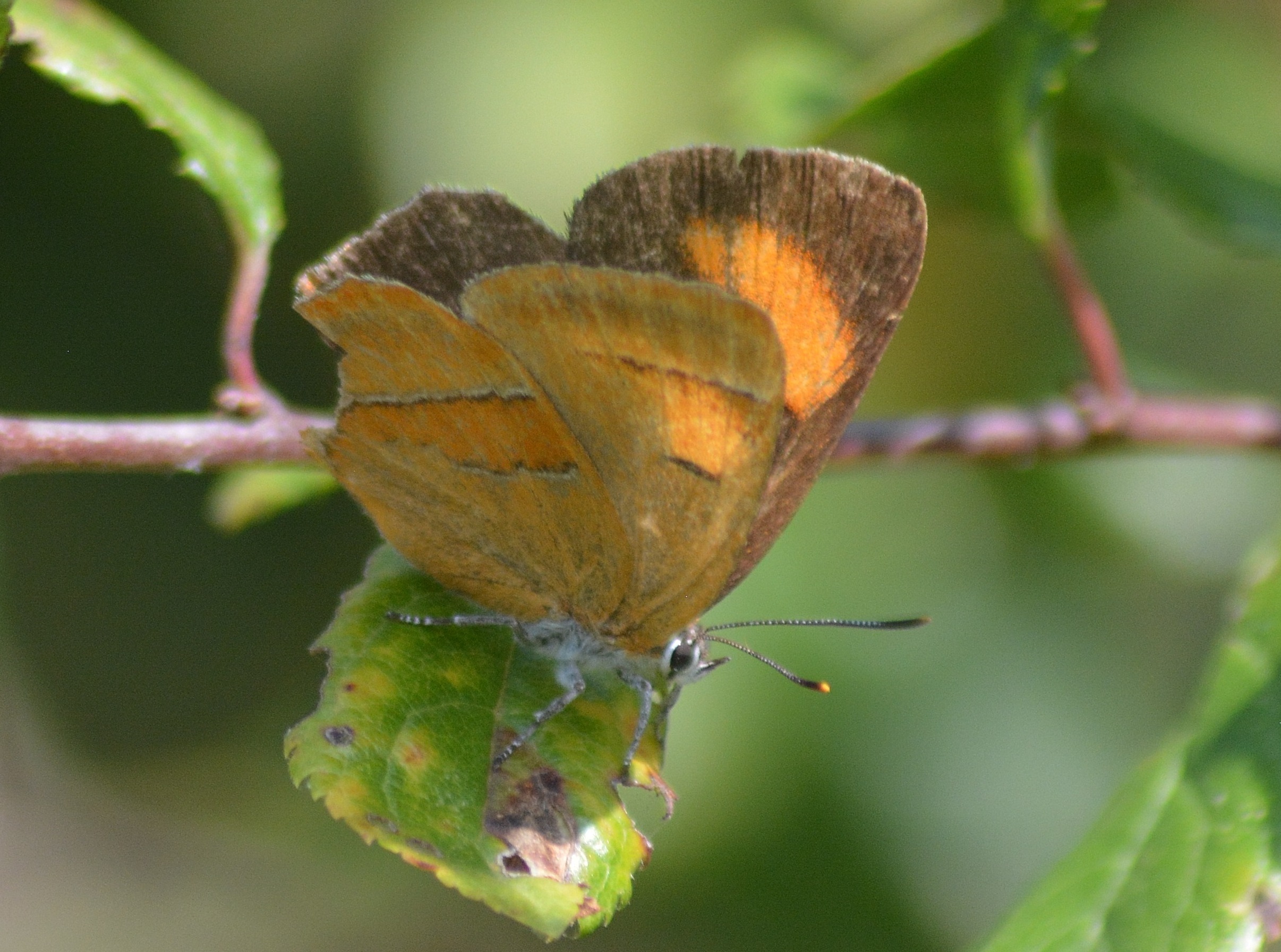
Fortunately, in September 2019, an egg-laying female Brown Hairstreak was twice seen in the blackthorn hedge behind the football pitch at the White Street sports field near the woodland. The first sighting was brief, but in the second sighting, a week later, the female was clearly making her way down the hedge choosing suitable egg-laying sites.
This individual was rather worn and had lost her 'tails' (see photo right by Tony Hoskin) but was a very welcome sight as the butterfly is rarely seen. Fortunately, it was decided not to cut the edge this yearso hopefully some eggs will survive the winter to emerge next spring.
MIGRANTS
Numbers of some of our native butterflies, like Large Whites, are boosted by migration from the continent in the summer months. Red Admirals used to be considered a migrant species, but now frequently overwinter in the UK, though their numbers are increased by migration in the summer. One butterfly that occurs regularly in the UK in summer and is a definite migrant is the Painted Lady , numbers of which vary greatly from year to year but is usually seen at the Community Woodland nectaring on knapweed or thistle. Another summer visitor to the UK is the Clouded Yellow, though this has not yet been reported at the woodland. Do let us know if you see one.
Painted Lady
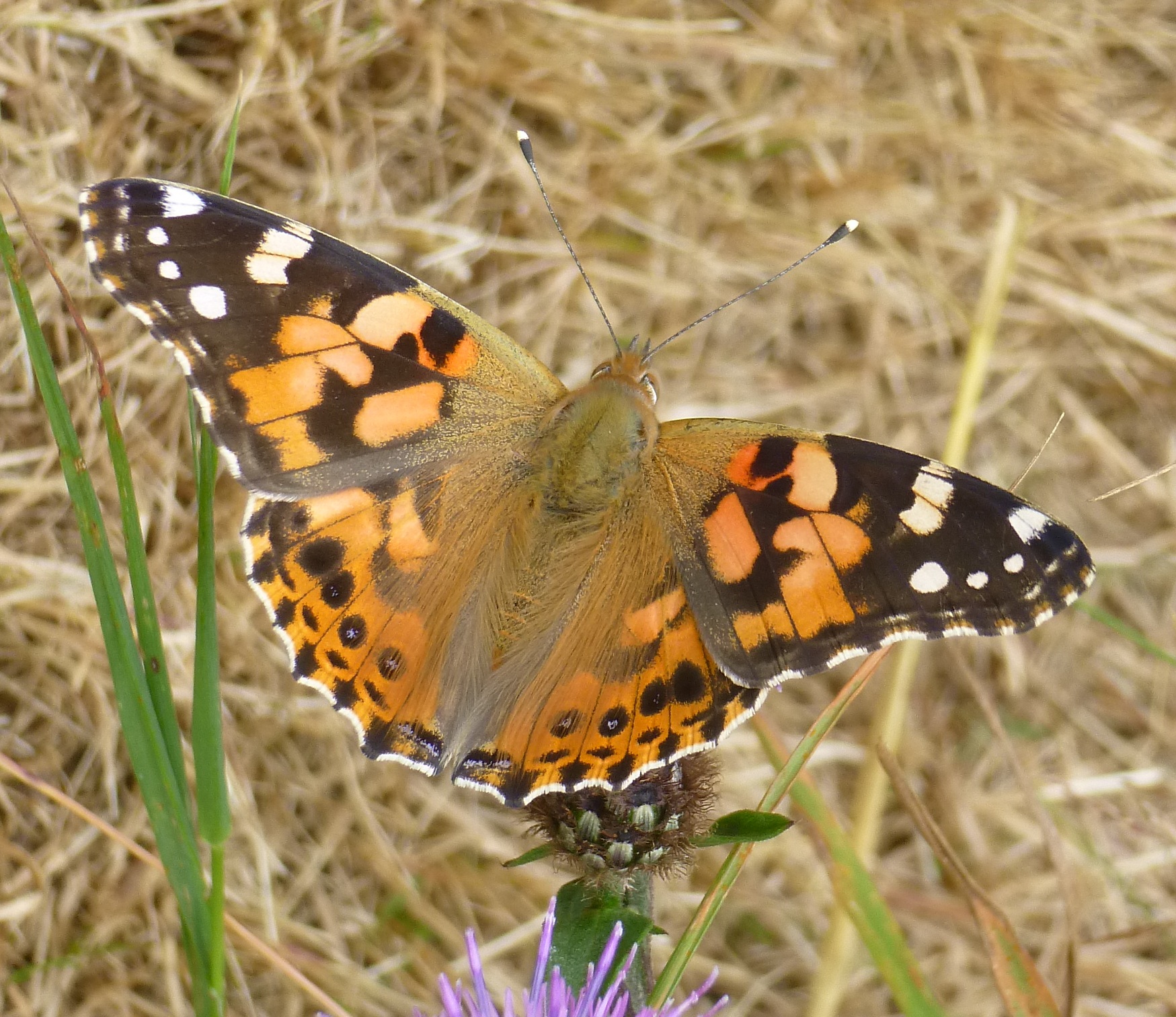
Related to the Red Admiral, with rather similar markings, though of a more salmon pink colour which fades to pale orange with age, this butterfly is a powerful flyer which makes a long migration from North Africa in several generational stages.
It can be more numerous in some years than others, but generally can be seen at the woodland and in gardens, feeding up on nectar. It lays its eggs on different types of thistle.
2019 proved to be a Painted Lady year with many sightings, particularly in the north of the country (Painted Lady topped the Big Butterfly Count for 2019), though we had many sightings in North Curry and it was seen on the butterfly bank at the woodland.
Clouded Yellow
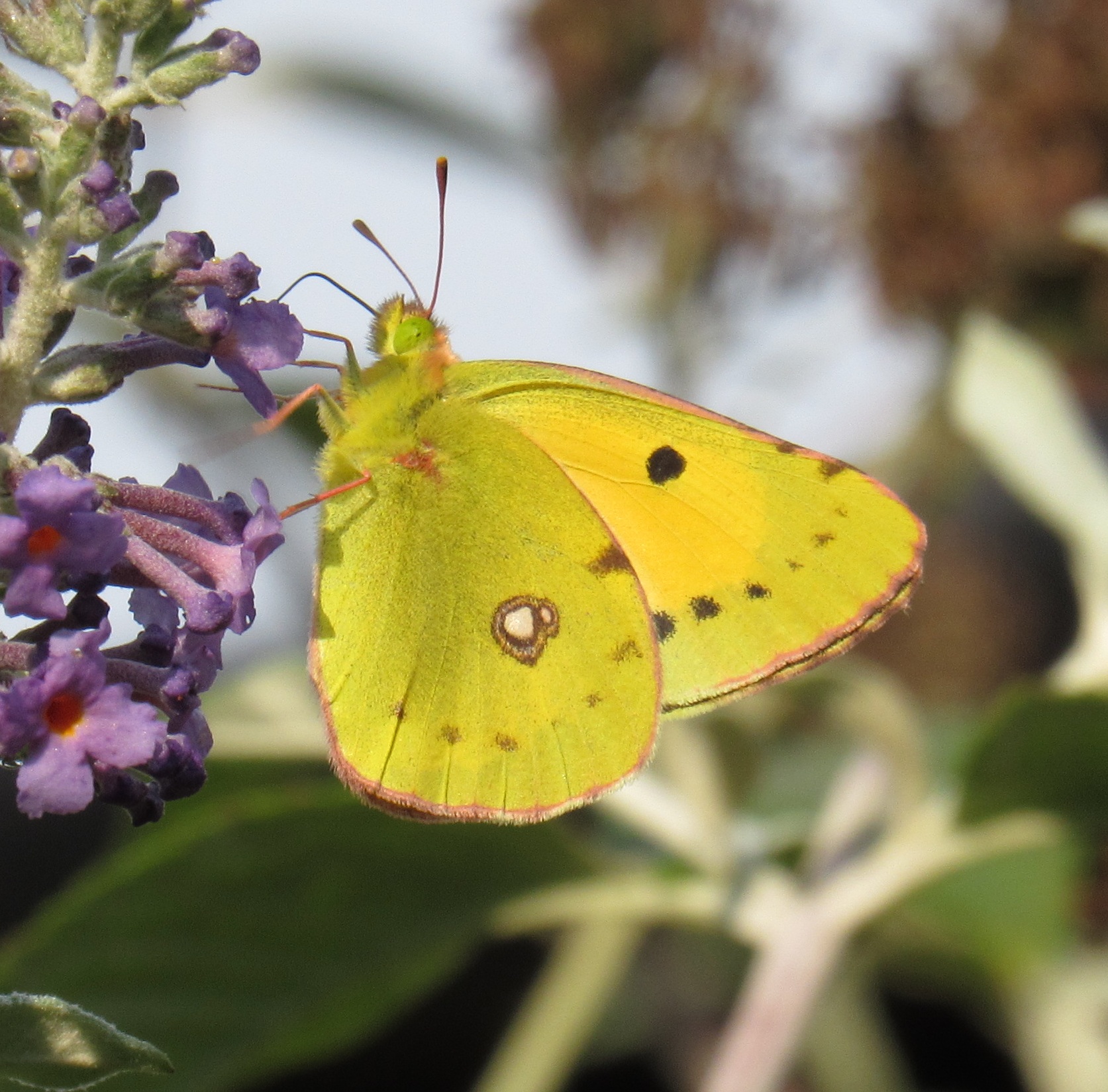
This butterfly is a much richer yellow than the Brimstone, with upper wings edged in black, which visits this country in irregular numbers in the summer. They are more likely to be found on chalk downs and in clover fields, but can come into gardens and could possibly be seen at the woodland in a good year. They are very fast flyers and don’t seem to pause for long to nectar, but do let us know if you see one at the woodland.